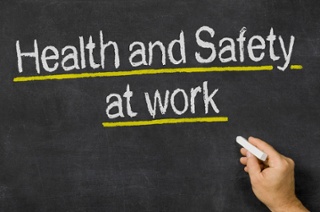First and foremost we must try and pin down the elusive definition of ‘Health and Safety’.
The Oxford Dictionary definition reads; ‘Regulations and procedures intended to prevent accident or injury in workplaces or public environments’. Sounds simple enough but in truth the dynamics between the employers and employees can often be at loggerheads; perception as to ‘what is a safe working environment’ will vary, causing conflict in varying degrees.
 The actual working conditions, state of machinery and general facilities, add to the confusion. What is acceptable practice? This question is of course subject to interpretation.
The actual working conditions, state of machinery and general facilities, add to the confusion. What is acceptable practice? This question is of course subject to interpretation.
Nevertheless it really is a good idea to try and improve the Health and Safety culture within your business. Training is perhaps the first logical solution; but as a word of warning training programs need to take account of the views from ‘the shop floor’: from the people with hands-on experience. A collusion and understanding between management and employees will help ensure good Health and Safety practices are followed by agreement.
Workplace hazards need to be identified then guidelines and procedures set in place with the aim of reducing accidents. Furthermore procedures should also cover ‘accident response’; coping with potential hazardous aftermaths of an accident, such as exposure to toxic spillage. One huge safety risk in the workplace is that fires could easily arise, so it’s essential that you purchase the correct items, such as fire extinguishers from fireprotectiononline.co.uk, and go through the correct safety protocols with all employees.
With this in mind emergency preparedness must also form part of every workplace Health and Safety culture. This means installation of effective procedures and the availability and effective use of protective equipment such as goggles, clothing and other appropriate items such as first aid kits and eye wash solutions.
However, effective procedures can only be formulated from known data; data collated from sound research of workplace incidents and employees’ perceptions. Identify where, how and why accidents occur. Identify where there are bad practices that may lead to incidents; what do the personnel on the ground floor perceive as a potential risk? There has to be collaboration at all levels with clear directives and guidelines issued and endorsed from the top.
It is essential to establish ongoing safety training sessions; Health and Safety will soon become very much a part of the whole work culture. ‘Best Practices’ once accepted will be adhered to for the ultimate benefit of all concerned. It is essential to honestly assess current procedures and adapt and change them as necessary.
Safety in the workplace must not be merely endorsed as a paper exercise, it must become ingrained in the executive and workers’ consciousness. Safety is a collective responsibility, from bottom to top, it must become a core value.
If your company is big enough perhaps you could appoint a team responsible for Health and Safety evaluation and implementation. Do whatever you can to keep the issue on the front burner. Maybe a reward system for workers who come up with suggestions to improve safety?
With constant communication and monitoring, incidents and accident will fall. Don’t become complacent, stay on top and continue to reinforce the importance of a Health and Safety culture.
You may provide the best, safest equipment in the world, but without a Health and Safety culture poor work practices could herald a negative, sloppy and potentially destructive culture. Remember the road to good Health and Safety culture may be a bit bumpy, but persevere, the benefits are well worth the journey.
A healthy, safe workplace makes for a happier workplace; a happy working environment is a more efficient working environment.





